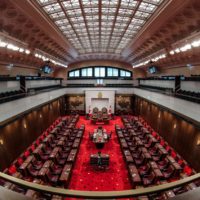
News
Bill C-69 becomes law
Senator Grant Mitchell, who sponsored Bill C-69 in the Senate, reflects on the legislative process after it becomes law.
Bill C-69 recently received Royal Assent and became law. This bill has been the subject of much debate, especially in my province of Alberta. I have prepared this document to explain why I think this bill is so critical for the success of major projects in Alberta and across Canada, and why I sponsored it and supported it throughout the Senate process.
The foundation of this bill is that it creates a much more efficient and predictable process while enhancing public trust, which is essential to reducing the risk of litigation so that good projects can actually be built.
A mix of intensely competing interests, vocal stakeholders, historical grievance, emotion and high economic and environmental stakes has defined the nature of the C-69 debate. It has become a proxy for a broader and deeper issue that Canadians cannot avoid and must debate. We are at a critical inflection point in our history: Canadians, and perhaps in particular Albertans, are facing unrelenting environmental, social and market pressures about how we will develop an economy of the future to sustain our prosperity, while confronting increased angst and fear about the environment.
With that in mind, the natural resources sector accounted for 17 per cent of Canada’s GDP and provided over 1.8 million jobs to Canadians in 2017, much of it focused in Alberta. Albertans’ hard work, ingenuity, innovation and investment create economic prosperity that significantly benefits people across this country.
For Albertans, the energy industry is visceral, emotional and deeply significant. It is how we feed our kids, pay our mortgages, define ourselves, envision our future and calculate the tremendous contribution we have made to the prosperity and strength of this remarkable country.
Bill C-69 is the culmination of a long and arduous, but credible policy-making process. It started with the realization that the current regime, Canadian Environmental Assessment Act (CEAA 2012), was not working. It had failed to get critical projects built, did not have the trust of Indigenous peoples or of the public at large and, as a result, had been mired in litigation that has so unsettled investors. It had to be fixed.
The Government did what a responsible Government facing this kind of challenge would do. They undertook a public consultation process of over two years in length to understand what stakeholders and the Canadian public in general would expect of project assessments. This involved two expert panel reviews, hundreds of meetings and written submissions and thousands of online comments. It was also subject to 16 months of Parliamentary review in the House of Commons and the Senate.
From this process, the Government identified fundamental principles to define the bill that would replace CEAA 2012: the impact assessment process would have to protect the environment, build public trust, provide certainty for industry and investors, and respect Indigenous rights and interests. A guiding principle to doing this properly was the understanding that we cannot simply elevate one set of interests arbitrarily over other sets of interests. The key to success in this process is to find a balance and an alignment amongst the competing interests inherent in resource development.
Strengths of Bill C-69
First I’d like to briefly mention some of the strengths that were built into C-69 even before it was amended:
- Shorter timelines: The bill shortens every timeline that was in place under CEAA 2012. The assessment stage for most projects will drop from 720 days to 300 days. Non-designated pipelines will drop from 450 to 300 days.
- Limited Reasons for Extensions: Reasons for which timelines can be extended will be reduced to three, all of which are under the control of the proponent. Currently, there are no such limits.
- Consideration of Positive Impacts: Whereas CEAA 2012 looked only at adverse environmental impacts, Bill C-69 looks at the variety of ways projects can impact communities, economies, and ecosystems, including the positive impacts of projects. For example, CEAA 2012 had no mention of economic benefits. C-69 mentions them 171 times.
- Early Planning: The Bill establishes an early planning process which will formally require federal departments and agencies to work with the proponent to plan out and prepare for the assessment. There will be five structured outputs required of the Impact Assessment Agency (the Agency) that will clarify what is expected of the proponent early in the process: the Tailored Impact Statement Guidelines, an Indigenous Engagement and Partnership Plan, a Public Participation Plan, a Cooperation Plan, and a Permitting Plan.
- Better coordination between federal and provincial processes: The bill provides for more flexibility and opportunity to align federal and provincial processes. Provinces and territories and other jurisdictions will be included in federal reviews through joint panel reviews, delegation, or substitution.
- Advancing reconciliation: Bill C-69 requires that impacts on Indigenous communities be assessed and that Indigenous knowledge be considered in assessment reports. It makes explicit reference to the UN Declaration of the Rights of Indigenous People. Furthermore, Indigenous jurisdictions are given a stature commensurate with provincial and territorial governments under new provisions for substitution and delegation of impact assessments.
- Role of the Minister: The Minister of the Environment will not make the final decision on any energy project. Approval decisions on all projects that are led solely by the Agency will be made by Cabinet, and all energy projects involve another department (for example, Natural Resources), and/or a lifecycle regulator or offshore boards.
Senate review and amendments
The Senate has subjected the bill to extensive scrutiny over the past year. In addition to the many emails, calls, and meetings that Senators received and participated in, the Energy and Environment Committee heard from 275 witnesses over 108 hours of hearings in 10 cities all across the country and received 121 briefs.
Based on this extensive study, the Senate proposed a large number of amendments to the bill. The Government accepted 62 of these amendments outright and another 37 with some modification, for a total of 99. This is historic: it is the greatest number of Senate amendments accepted by the House of Commons since this information was first recorded, starting in the 1940s.
The 99 amendments accepted by the Government build on the principles developed through consultations with Canadians. The amendments enhanced Bill C-69 by collectively addressing an array of key issues raised by stakeholders throughout our deliberations in the Senate. These include:
- Ministerial Discretion: Many amendments shifting powers from the Minister of Environment to the Agency were accepted in order to, among other things, manage time limits throughout assessments, determine when sufficient information has been received, and appoint members of review panels.
- Certainty and predictability: The recognition of the positive economic impacts of projects has been further emphasized with amended wording in the purpose section of the bill. The scope of factors will also be defined earlier in the process.
- Litigation risk: Amendments to the scoping of factors help minimize ligation risk by making it clear early on what must be considered, to what extent, and by whom. The likelihood of court challenges is also reduced by measures throughout the bill designed to build public trust, including better consultation with the public and Indigenous peoples and, crucially, consideration of Indigenous rights at every stage of the process.
- Timeliness: Amendments have further tightened timelines to ensure that both the review panel’s report and the Agency’s recommendations to the Minister must be finished within the specified time limits of 300 or 600 days. The Agency will also now be required to publish reasons for all extensions to the legislated timelines, including those decisions made by Cabinet.
- Public Participation: The Agency’s power to ensure that public participation is meaningful and appropriate was reinforced in amendments to the early planning process, Agency-led assessments, review panel assessments, and to regional and strategic assessments. And, there are provisions in the bill requiring that public consultation must be completed within the prescribed timelines.
- Role of Lifecycle Regulators: It will now be possible for members of CER, CNSC and the two offshore boards to chair review panels.
- Assessment of Offshore Exploratory Wells: We heard the concern that offshore exploratory wells should no longer be subjected to individual reviews, as is now required under CEAA 2012. Provisions to allow for regional assessments to be used instead of individual assessments are already in the draft regulations and were further reinforced in the amendments.
- Recognition of Indigenous Rights: An amendment clarified that impact benefit agreements with Indigenous communities are not prohibited prior to an impact assessment being completed. Other amendments added references to the rights of indigenous women.
- Role of other Jurisdictions: An amendment affirmed that the legislative competencies of provincial and federal governments will be respected.
- Canadian Navigable Waters Act: The Senate made amendments to reduce the administrative burden in proceeding with works that clearly will not affect navigation. Amendments were also made to restore the previous provisions referring to emergencies as events that threaten to cause social disruption or a breakdown in the flow of essential goods and services. Finally, for greater certainty, a clause is being added to the definition section of the bill to affirm that navigable water does not mean irrigation channels or drainage ditches.
Examples of amendments that were not accepted
- Downstream Emissions: An amendment requiring the assessment of global emissions was rejected because by definition that would mean assessing downstream emissions. The government has been very clear in its commitment not to require the assessment of downstream emissions.
- Privative Clause: An amendment to introduce a privative clause – said to limit legal challenges to decisions – into the Impact Assessment Agency section of the bill was rejected. The Department of Justice argues that such a privative clause applies effectively to quasi-judicial tribunals like the Canadian Energy Regulator and the National Energy Board because of the courts are more inclined to defer to quasi-judicial tribunals. Despite this, a privative clause in the NEB Act has not prevented challenges to major pipeline projects so far. For these reasons, a privative clause in the Impact Assessment Act would likely be ineffective in reducing the likelihood of litigation.
- Standing Test: amendments to reintroduce a standing test were not accepted. These would have been contrary to the recommendations of the Report of the Expert Panel on the Modernization of the National Energy Board, which explicitly pointed to the standing test as having contributed to public frustration since its introduction to the NEB process under CEAA 2012. It is important to note that, in any event, over 60% of the projects reviewed under CEAA 2012 have not been subject to a standing test, which has applied only to NEB project reviews. The power of the Agency, the life cycle regulators, and the offshore boards to manage public participation and amendments is established in law and in practice, and this power was reiterated in several of the accepted amendments.
- Maximum Timelines: Amendments to set maximum timelines were not accepted. A lack of flexibility to extend a decision could result in arbitrary rejections of projects or create litigation risk.
My support for Bill C-69 stemmed from my belief that we needed to confront the problems we have had with getting major projects built, despite the difficulty and emotion it raised for so many. The bill was based on broad public consultation and included significant measures to fix the problems of CEAA 2012. It was then further enhanced through our extensive parliamentary review. The Government listened and responded in a significant way to the Senate amendments. I am convinced that the final bill will ensure projects get built, to contribute to Canada’s prosperity while protecting and sustaining the environment that is so important to all Canadians.




















































